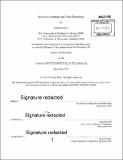Rhyming grammars and Celtic phonology
Author(s)
Kern, Gretchen
DownloadFull printable version (13.18Mb)
Other Contributors
Massachusetts Institute of Technology. Department of Linguistics and Philosophy.
Advisor
Donca Steriade.
Terms of use
Metadata
Show full item recordAbstract
This dissertation broadens our understanding of a typology of poetic rhyme through the analysis of three rhyming traditions that show unconventional patterns in the contents, position, and size of rhyme domains. The rhyme domain (RD) is a string of segments that stand in correspondence with another string of segments in a poetic constituent. In Early Irish poetry, strict identity of consonants in RDs is not required, but consonants instead correspond based on membership in defined classes. These classes correlate with sonority levels. Though analysis of VCC and bisyllabic rhymes, which match for sonority, but not featural identity, across the RD, I show that poetic rhyme can be sensitive to the sonority profile of a rhyme, and not just to similarity of segments. Statistical analysis of a rhyming corpus provides further evidence for this. Old Norse skaldic rhyme shows an unusual position for RDs. Rather than occurring at the end of two lines in a couplet, both RDs appear in the middle of a single line. One of these RDs will occupy the penultimate syllable of a bisyllabic word, which means that the rhyme will begin and end word-internally. This gives evidence for rhyme being based not on a syllable rime, but on the interval: a metrical constituent that spans from one vowel to the following vowel including all intervening consonants. The four types of Welsh cynghanedd I analyze present challenges in terms of the size, position, and contents of the RD. In all four types, the RDs occur with in a single line, like skaldic, but the position, size, and number of the RDs are less predictable. The RDs may span the entire line, or may contain only a single interval or consonant each. My analysis shows that all four types of cynghanedd can be analyzed as separate poetic grammars drawing on the same set of constraints in different rankings. A few constraints maintain a fixed ranking across all four cynghanedd grammars. Analysis of these three apparent outliers contributes to the development of a typology of rhyme, showing that even extreme cases draw on familiar concepts to define their RDs.
Description
Thesis: Ph. D. in Linguistics, Massachusetts Institute of Technology, Department of Linguistics and Philosophy, 2015. Cataloged from PDF version of thesis. Includes bibliographical references (pages 158-161).
Date issued
2015Department
Massachusetts Institute of Technology. Department of Linguistics and PhilosophyPublisher
Massachusetts Institute of Technology
Keywords
Linguistics and Philosophy.